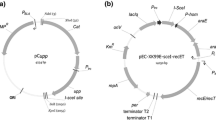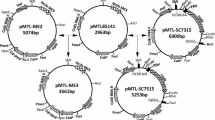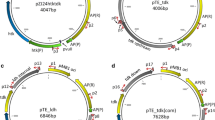Abstract
We herein adapted a markerless gene replacement method by combining a temperature-sensitive plasmid pKSV7 with a counterselectable marker, the upp gene encoding uracil phosphoribosyltransferase (UPRTase), for the poly-γ-glutamic acid (γ-PGA)-producing strain Bacillus amyloliquefaciens LL3. Deletion of the upp gene conferred LL3 5-fluorouracil (5-FU) resistance. Sensitivity to 5-FU was restored when LL3 Δupp was transformed with pKSV7-based deletion plasmid which carries a functional allele of the upp gene of Bacillus subtilis 168. These observations allowed us to adapt a two-step plasmid integration and excision strategy to perform markerless deletion of genes of interest. Deletion plasmid harboring a mutant allele of the target gene was first integrated in the genome by culturing cells under nonpermissive conditions for pKSV7 replication. Single-crossover recombinants were then grown without antibiotics to aid the second recombinational event. 5-FU was used to select for double-crossover recombinants with plasmid evicted from the chromosome. The resulting recombinants either harbored the wild-type or mutated allele of the target gene and could be identified by PCR and DNA sequencing. Using this method, we successively removed the amyA gene and a 47-kb fragment of the bae cluster from the genome of LL3, with higher efficiency compared with previous reports. We also investigated the effects of a transcriptional regulator, RocR, on γ-PGA production and cell growth. Specific γ-PGA production of the rocR mutant was increased by 1.9-fold, which represents a new way to improve γ-PGA production.




Similar content being viewed by others
References
Bajaj I, Lele S, Singhal R (2009) A statistical approach to optimization of fermentative production of poly (gamma-glutamic acid) from Bacillus licheniformis NCIM 2324. Bioresour Technol 100:826–32
Biswas I, Gruss A, Ehrlich SD, Maguin E (1993) High-efficiency gene inactivation and replacement system for gram-positive bacteria. J Bacteriol 175:3628–35
Cao M, Song C, Jin Y, Liu L, Liu J, Xie H, Guo W, Wang S (2010) Synthesis of poly (γ-glutamic acid) and heterologous expression of pgsBCA genes. J Mol Catal B Enzym 67:111–6
Cao M, Geng W, Liu L, Song C, Xie H, Guo W, Jin Y, Wang S (2011) Glutamic acid independent production of poly-γ-glutamic acid by Bacillus amyloliquefaciens LL3 and cloning of pgsBCA genes. Bioresour Technol 102:4251–7
Datsenko KA, Wanner BL (2000) One-step inactivation of chromosomal genes in Escherichia coli K-12 using PCR products. Proc Natl Acad Sci 97:6640–5
Fabret C, Ehrlich SD, Noirot P (2002) A new mutation delivery system for genome-scale approaches in Bacillus subtilis. Mol Microbiol 46:25–36
Gangadharan D, Sivaramakrishnan S, Nampoothiri KM, Sukumaran RK, Pandey A (2008) Response surface methodology for the optimization of alpha amylase production by Bacillus amyloliquefaciens. Bioresour Technol 99:4597–602
Geng W, Cao M, Song C, Xie H, Liu L, Yang C, Feng J, Zhang W, Jin Y, Du Y, Wang S (2011) Complete genome sequence of Bacillus amyloliquefaciens LL3, which exhibits glutamic acid-independent production of poly-γ-glutamic acid. J Bacteriol 193:3393–4
Goh YJ, Azcárate-Peril MA, O’Flaherty S, Durmaz E, Valence F, Jardin J, Lortal S, Klaenhammer TR (2009) Development and application of a upp-based counterselective gene replacement system for the study of the S-layer protein SlpX of Lactobacillus acidophilus NCFM. Appl Environ Microbiol 75:3093–105
Gunka K, Commichau FM (2012) Control of glutamate homeostasis in Bacillus subtilis: a complex interplay between ammonium assimilation, glutamate biosynthesis and degradation. Mol Microbiol 85:213–24
Keller KL, Bender KS, Wall JD (2009) Development of a markerless genetic exchange system for Desulfovibrio vulgaris Hildenborough and its use in generating a strain with increased transformation efficiency. Appl Environ Microbiol 75:7682–91
Kristich CJ, Manias DA, Dunny GM (2005) Development of a method for markerless genetic exchange in Enterococcus faecalis and its use in construction of a srtA mutant. Appl Environ Microbiol 71:5837–49
Liu J, Ma X, Wang Y, Liu F, Qiao J, Li XZ, Gao X, Zhou T (2011) Depressed biofilm production in Bacillus amyloliquefaciens C06 causes γ-poly-glutamic acid (γ-PGA) overproduction. Curr Microbiol 62:235–41
Manabe K, Kageyama Y, Morimoto T, Ozawa T, Sawada K, Endo K, Tohata M, Ara K, Ozaki K, Ogasawara N (2011) Combined effect of improved cell yield and increased specific productivity enhances recombinant enzyme production in genome-reduced Bacillus subtilis strain MGB874. Appl Environ Microbiol 77:8370–81
Manabe K, Kageyama Y, Morimoto T, Shimizu E, Takahashi H, Kanaya S, Ara K, Ozaki K, Ogasawara N (2013) Improved production of secreted heterologous enzyme in Bacillus subtilis strain MGB874 via modification of glutamate metabolism and growth conditions. Microb Cell Fact 12:18
Morimoto T, Kadoya R, Endo K, Tohata M, Sawada K, Liu S, Ozawa T, Kodama T, Kakeshita H, Kageyama Y, Manabe K, Kanaya S, Ara K, Ozaki K, Ogasawara N (2008) Enhanced recombinant protein productivity by genome reduction in Bacillus subtilis. DNA Res 15:73–81
Okibe N, Suzuki N, Inui M, Yukawa H (2011) Efficient markerless gene replacement in Corynebacterium glutamicum using a new temperature-sensitive plasmid. J Microbiol Methods 85:155–63
Rachinger M, Bauch M, Strittmatter A, Bongaerts J, Evers S, Maurer KH, Daniel R, Liebl W, Liesegang H, Ehrenreich A (2013) Size unlimited markerless deletions by a transconjugative plasmid-system in Bacillus licheniformis. J Biotechnol 167:365–9
Rairakhwada D, Seo JW, Seo M, Kwon O, Rhee SK, Kim CH (2010) Gene cloning, characterization, and heterologous expression of levansucrase from Bacillus amyloliquefaciens. J Ind Microbiol Biotechnol 37:195–204
Redder P, Linder P (2012) New range of vectors with a stringent 5-fluoroorotic acid-based counterselection system for generating mutants by allelic replacement in Staphylococcus aureus. Appl Environ Microbiol 78:3846–54
Sauer U, Cameron DC, Bailey JE (1998) Metabolic capacity of Bacillus subtilis for the production of purine nucleosides, riboflavin, and folic acid. Biotechnol Bioeng 59:227–38
Scoffone V, Dondi D, Biino G, Borghese G, Pasini D, Galizzi A, Calvio C (2013) Knockout of pgdS and ggt genes improves γ-PGA yield in B. subtilis. Biotechnol Bioeng 110:2006–12
Shi F, Xu Z, Cen P (2006) Efficient production of poly-gamma-glutamic acid by Bacillus subtilis ZJU-7. Appl Biochem Biotechnol 133:271–82
Shih IL, Van YT (2001) The production of poly (γ-glutamic acid) from microorganisms and its various applications. Bioresour Technol 79:207–25
Smith K, Youngman P (1992) Use of a new integrational vector to investigate compartment-specific expression of the Bacillus subtilis spoIIM gene. Biochimie 74:705–11
Sung MH, Park C, Kim CJ, Poo H, Soda K, Ashiuchi M (2005) Natural and edible biopolymer poly-γ-glutamic acid: synthesis, production, and applications. Chem Rec 5:352–66
Wu Q, Xu H, Shi N, Yao J, Li S, Ouyang P (2008) Improvement of poly (gamma-glutamic acid) biosynthesis and redistribution of metabolic flux with the presence of different additives in Bacillus subtilis CGMCC 0833. Appl Microbiol Biotechnol 79:527–35
Xu Z, Shao J, Li B, Yan X, Shen Q, Zhang R (2013) Contribution of bacillomycin D in Bacillus amyloliquefaciens SQR9 to antifungal activity and biofilm formation. Appl Environ Microbiol 79:808–15
Xue GP, Johnson JS, Dalrymple BP (1999) High osmolarity improves the electro-transformation efficiency of the gram-positive bacteria Bacillus subtilis and Bacillus licheniformis. J Microbiol Methods 34:183–91
Zakataeva NP, Nikitina OV, Gronskiy SV, Romanenkov DV, Livshits VA (2010) A simple method to introduce marker-free genetic modifications into the chromosome of naturally nontransformable Bacillus amyloliquefaciens strains. Appl Microbiol Biotechnol 85:1201–9
Zhang Y, Buchholz F, Muyrers JP, Stewart AF (1998) A new logic for DNA engineering using recombination in Escherichia coli. Nat Genet 20:123–8
Zhang G, Bao P, Zhang Y, Deng A, Chen N, Wen T (2011) Enhancing electro-transformation competency of recalcitrant Bacillus amyloliquefaciens by combining cell-wall weakening and cell-membrane fluidity disturbing. Anal Biochem 409:130–7
Zhang W, Xie H, He Y, Feng J, Gao W, Gu Y, Wang S, Song C (2013) Chromosome integration of the Vitreoscilla hemoglobin gene (vgb) mediated by temperature-sensitive plasmid enhances γ-PGA production in Bacillus amyloliquefaciens. FEMS Microbiol Lett 343:127–34
Acknowledgments
This work was supported by the National Key Basic Research Program of China (“973”-Program) 2012CB725204; the National High Technology Research and Development Program of China (“863”-Program) 2012AA021505; the Natural Science Foundation of China Grant Nos. 31170030, 31300032, and 51073081; and the Project of Tianjin, China (13JCZDJC27800, 13JCYBJC24900, and 13JCQNJC09700). This work was also supported by the Ph.D. Candidate Research Innovation Fund of Nankai University.
Conflict of interest
The authors declare that they have no conflict of interest.
Author information
Authors and Affiliations
Corresponding authors
Rights and permissions
About this article
Cite this article
Zhang, W., Gao, W., Feng, J. et al. A markerless gene replacement method for B. amyloliquefaciens LL3 and its use in genome reduction and improvement of poly-γ-glutamic acid production. Appl Microbiol Biotechnol 98, 8963–8973 (2014). https://doi.org/10.1007/s00253-014-5824-2
Received:
Revised:
Accepted:
Published:
Issue Date:
DOI: https://doi.org/10.1007/s00253-014-5824-2




